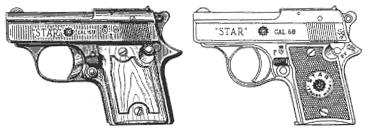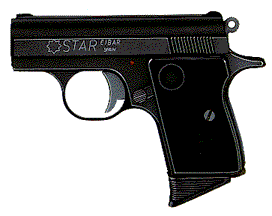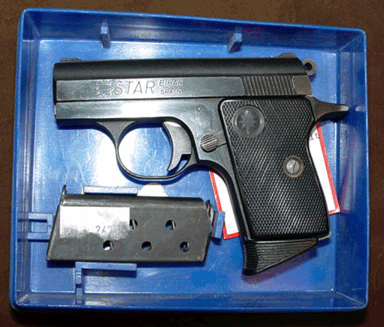Star Firearms — E-series pistols
These are the very smallest of the Star vest pocket pistols, and are on par with the smallest competing autoloading .22 and .25 pistols, then or now. I have no photos at all of the model E, so if anyone has one, please send me one, or contact me for details on getting good quality photos of small objects.
Manuals & Disassembly Instructions
I do not have manuals for every pistol shown on this site. However, in many cases there is a related manual. Partly to make the series relationships clearer, and partly to assist with speed and accuracy of updating, all manuals can be found in one place, the manuals page. All manuals available are provided as downloadable PDFs, or you may purchase a printed copy of the entire set of handgun manuals.
All vest-pocket and target pistols operate and strip in approximately the same way. These manuals are very slim, and do not provide really useful step-by-step instructions. It may be beneficial to review all the manuals for this series to assure you have gotten all relevant information.
As some of these manuals are not in english, and have no diagrams, I will explain the basic takedown procedure here. Stripping is just like taking down most any straight-blowback, fixed barrel european gun (e.g. the Walther PPK). This is, however, somewhat unusual if you have only worked with larger Browning lock pistols in the past.
- As with any time you are working on a pistol, assure it is empty first.
- Remove the magazine and cycle the slide several times.
- Push down on the button at the top of the left grip panel, in front of the safety lever.
- While holding this button down, pull the slide to the rear approximately 1/2".
- In this position, the slide can now come up thru notches in the slide rails. Pull the rear of the slide up,/em. off the rails. Use caution, as the slide is still under full spring pressure.
- Lower the slide over and off the end of the barrel. Be careful not to scratch the barrel or other parts.
- Reassemble in the reverse manner.

Model E
The model E is a clear derivation of the other Star vest pocket pistols, themselves derived from the basic layout of the F-series .22 target pistol. It is a straight blowback weapon, with all steel construction. The slide, as on the model F and other compact pistols, does not entirely encompass the barrel. This would serve to reduce weight and bulk.
The most unusual feature, for a gun so small, is the external hammer. Though not unheard of, it add complexity and can snag when attempting to fire from concealment, as from a coat pocket. The safety lever remained in the forward position, behind the trigger guard, for the entire production run. This is not difficult to use, as the small size allows the thumb to sweep the safety in this position, but is interesting as all other compact, F-derived Star pistols followed the upgraded 1942 model F with the thumb-placed safety.
The sights are rudimentary, with a round-section front blade. The magazine release is at the normal "combat" position, behind the trigger guard; very unusual for such a small pistol. Only the one model seems to have been made, with no upgraded safety or other revisions released during its production. Introduced in 1925, it seems to have gone out of production in 1934, presumably in favor of increased sales of slightly larger guns, such as the I-series. Both wood and plastic grips were offered.

Starlite
First of all, I have no proof that the 1990s Starlite is actually related to the model E. I have classified it as such, because its so similar the differences are easier to discuss than the similarities.
The Starlite has a fully-enclosed slide, with lower sides, but an overall similar profile and cocking serrations. Sights are small, but improved, with a flat-cut front blade to aid in sighting, when possible. There is a much longer beavertail, or backstrap extension, to aid in control and prevent the improved rowell or "commander" hammer from biting the shooter's hand.
The beavertail is additionally much higher. With a corresponding "high cut" of the frontstrap/trigger guard interface, this allows the shooter to keep a higher grip on the gun. This generally reduces flip when shooting, but also should allow more of the shooter's hand on the same size gun. Recoil from such a small gun will be notable, even with the small caliber, so every bit helps.

The frame is aluminum alloy, which greatly helped keep the weight down, and therefore made it competitive in the world of ultra-compact pistols. The unusual safety position is retained, but the lever is more low-profile and suited to concealed or pocket carry. The safety position is not entirely unusual for modern pocket pistols, Beretta being another manufacturer with that layout.
The magazine latch is of the heel type, making changes harder, but presumably making the gun that much slicker, and eliminating accidental magazine releases. The magazines all appear to have a finger extension; this is silly, as it adds bulk to the carried package with no extra firepower benefit.
I am not sure where the takedown lever is, but its no longer under the left rear of the slide, where it could be expected to be.